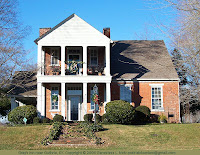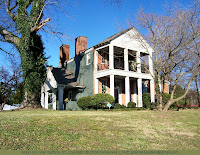Chokecherries, sand cherries, plums, grapes, and more
Over fifty years ago (can it be?), when I was very young, we lived south of Johnstown, Nebraska.
Sand cherries grew along the side of the road-trail that led from Highway 20 through the hills to our place and south to the McDaniel Ranch, Moon Lake, and beyond.
We picked so many sand cherries along the road one year that my mother set up an old window screen on blocks to help process them. She spread sand cherries across the screen and washed them with the garden hose. I don't know if she decided this technique was successful or not. I just remember several big buckets of sand cherries and the interesting things Mama was doing with them.
Grandma Nora came to visit and she talked to my mother about how some of the cherries were as big as her thumb. I deduce that they were not often that large. Many years later, I asked my mother about all of this, and she was surprised that I remembered it so well.
Those wild sandcherries would probably have been the western sandcherry,
Prunus pumila L. var. besseyi. Native Americans had
used sandcherries for millenia as fresh and dried fruit, but the great pioneer botanist of Nebraska,
Charles Edwin Bessey (1845-1915) gave the little silvery bush a Latin name and put it in its proper spot in botany's great structural diagram of earth's plant life.
My dad, a child of the Sandhills, loved sandcherry pie and my mother baked it for him whenever she had the fruit. Daddy's sandcherry pies were few and far between after we moved to Rose because we didn't have sandcherries there, but he developed a fondness for chokecherry pies. (More about chokecherries later.) I guess we may have been a little east of the natural range of sandcherries or maybe Duff Valley just wasn't a sandy enough spot.
We had windbreaks of trees (called "tree-pens" because they were fenced) around our ranch buildings. In one of the tree-pens, a big thicket of plum bushes grew. Their fruits were yellow and intensely bitter, and after her first harvest of them Mama didn't bother again. Still, in the spring they bloomed gloriously.
I remember a spring afternoon when we took the shortcut home from school, across the meadow and through the tree-pen. We could smell the sweet fragrance of the plum blossoms even before we saw them. We took a big armful of the blossoms to Mama. When we broke off the branches with their blooms, we were eliminating the fruit as well as mutilating the bushes, but the plums were always so sour that no one cared.
Wild Sandhill orchard
After we had lived at Rose for a few years, my dad bought some pasture land in Loup County, about 15 or 20 miles from our home place. The land was south of the Calamus River and much of it consisted of long ridges of big hills, actually grassed-over sand dunes, that ran mostly east and west. Thickets of wild plums were sprinkled across the south sides of many of those sandy ridges. These Loup County plums had a sweet, red fruit. The skins were sour, but the meat of the plums was delicious when ripe. The best way to eat them was to place the entire fruit in your mouth, bite into it, suck out the sweet juice and pulp, and then spit out the sour skin and the seed.
In one area of our most remote Loup County pasture, a long, wide sweep of prairie grasses lay between two high sandy ridges. Northwest of the windmill in that big valley, a very large plum thicket grew on the hillside. Small chokecherry trees grew within the tangle of plum bushes and wild grapes grew over the top of everything, so we called it "the orchard". In good years when spring weather was mild and no late frosts nipped the blossoms, all three fruits produced bounteously.
My mother often rode the Loup County pastures in the summer when all the men were busy making hay. Checking on the cattle, giving them salt and mineral, "doping" the backrubber with fly control, and making sure the windmill was working was called "riding the pastures" even though we rode in a pickup truck, not on horseback.
My sister and I went on these excursions to give my mother company and moral support as she bravely drove over treacherously sandy trails. We also opened the gates for her. Actually, I usually opened the gates because Charlotte was 5 years younger and shorter. (In all fairness, Charlotte may have had her turn at gate-opening later on after I started working in the hayfield.)
Riding the pastures always took an entire, long, hot summer afternoon, so I was never happy when my mom wanted to stop and pick fruit at the orchard. If I had picked faster, we might have left sooner, but I remember that Mama filled her buckets much quicker than I filled mine. Then when we were finally done picking, we had to stop at the windmill, so Mama could wash with lye soap to get the poison ivy off herself. It grew in the orchard, too, and she was very allergic.

My parents speculated that Indians had planted that hillside orchard.
Wild plums were common throughout our several sections of hills, but
chokecherries and
wild grapes grew only in that one big plum thicket. It was probably a couple of acres in size, on a wide, sunny hillside at the edge of a large valley. Their talk of Indians intrigued me, so I was greatly interested years later when I read these paragraphs in Stephen R. Jones' book,
The Last Prairie: A Sandhills Journal:
Plains Indians coveted chokecherries. They mashed them up and mixed them with bison fat to make pemmican, a winter staple, or crushed them to make a special drink. Many peoples refered to the August moon as the "black cherry moon" or "the moon of black cherries ripening." The Lakota drank chokecherry juice at ceremonies honoring a girl reaching puberty. The red juice represented both the sacred blood of the young woman and the fruits of the earth.
Plains Indian tribes would camp for days along streams where chokecherries grew. The women used stone pestles to pound the cherries to a pulp, pits and all. It's possible that people deliberately carried chokecherry seeds from one campsite to another, contributing to the spread of this moisture-loving shrub into arid regions.
My experiments with wild fruits
My childhood "fruiting" experiences instilled an interest in growing wild fruit. I bought some sand cherry bushes from a catalog and planted them here in Kentucky. They didn't do well, but during the few years that they lived, they produced a handful of cherries, and I picked and ate them right off the bush. I had forgotten their unique, dusky flavor.
Soon after we moved here, Keely became friendly with a little girl named Tiffany who had wild plums behind her house. I acquired a few plums from Tiffany's mother and started some bushes from the seeds. I planted them on a south facing slope that we don't enjoy mowing. I was hoping they would take over the slope, but they haven't yet. These plums produce a sour yellow fruit that I don't recommend eating straight from the bush, even when fully ripe.
Several years ago, I visited my brother's place in Kansas when their wild plums were ripe. Those plums are yellow and fairly sweet. The plum bushes are surprisingly small and scrubby, but I think they're stunted by the dry conditions that usually prevail in SW Kansas.
I brought home some Kansas plum seeds and planted them in a little bed, then transplanted them to the slope. Now, the Kansas Sweets are intermingled with the Kentucky Sours, and I can't tell them apart by looking. (Their fruit should identify them -- "
By their fruits ye shall know them.") I posted
their photo yesterday. If we don't get any more hard frost, I'll have a few plums to play with this summer.
Lewis and Clark's descriptions of the wild fruits of the Great Plains are summarized by the Mouth of the Platte Study Group in their webpage titled, "
Fruits." An interesting report from 1912 for the Smithsonian Institute about "Uses of Plants by the Indians of the Missouri River Region" can be downloaded (
126 page PDF).
More wild foods
My father was knowledgeable about many plants of the Sandhills. One day in the hayfield, when I was just a little girl, he showed me the low-growing
ground cherries in the stubble and how to open their little husks to find the seedy little fruits.
Daddy also showed us a wild purple flower that he called "Indian turnip". I have tried to identify it in a book of Nebraska wildflowers, and I can only say that it
might have been
liatris squarrosa (
scaly blazing star). It had a small edible bulb with a woody texture and a sharp bitter flavor. They didn't taste very good, but it was fun to think that I knew something from Indian lore.
Our family ate and greatly enjoyed a certain type of wild mushroom that came up after a rain in areas where the cattle had been hayed during the winter. I have studied mushroom books, and I think it was the
meadow mushroom.
If you have read all the way to the bottom of this long, long ramble, I congratulate you.


 The historic marker notes that Gray's Inn was built in 1833 as a stagecoach stop by Major John P. Gray, the man who founded Elkton. The National Park Service adds that the inn served several stage lines. I think it's likely (I am guessing) that stagecoaches from Nashville, Bowling Green, Elkton and Hopkinsville met here.
The historic marker notes that Gray's Inn was built in 1833 as a stagecoach stop by Major John P. Gray, the man who founded Elkton. The National Park Service adds that the inn served several stage lines. I think it's likely (I am guessing) that stagecoaches from Nashville, Bowling Green, Elkton and Hopkinsville met here.
